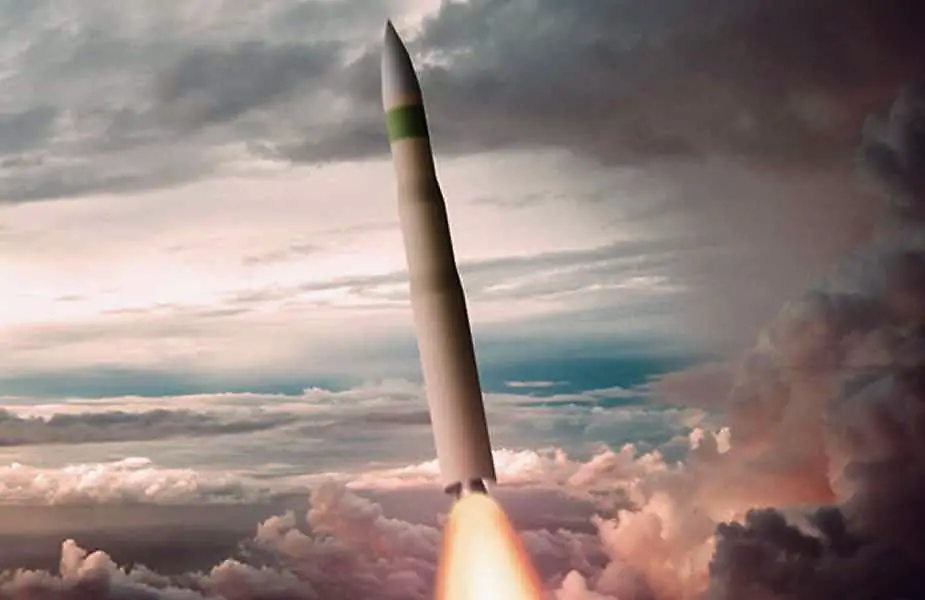US Department of Defense tackling nuclear modernization with proactive and integrated approach
The U.S. Defense Department is instituting a forward-leaning, whole-of-department approach in accomplishing its top priority of maintaining the world's foremost nuclear deterrence capability, a top Pentagon official said on August 25. Joseph Clark, US DoD, reports.
Follow Army Recognition on Google News at this link

Concept rendering of the U.S. Air Force's LGM-35A intercontinental ballistic missile (Drawing source: U.S. Air Force)
Deborah G. Rosenblum, assistant secretary of Defense for nuclear, chemical and biological defense programs and executive secretary of the Nuclear Weapons Council said her top priority is ensuring the entire DOD is aligned and proactive as it executes its nuclear modernization efforts. "This work is so important and so vital and is really a no-fail mission for us, we need to make sure that the senior-most leadership of the department remains focused on it, is actively working on it is solving problems and challenges," she said.
The 2022 Nuclear Posture Review identified the modernization of the U.S. nuclear arsenal as a top priority in maintaining a strong nuclear deterrence. That modernization effort, which is being carried out over the next two decades, includes initiatives to modernize all three legs of the nuclear triad.
Under the effort, the U.S. will field the Sentinel intercontinental ballistic missile system to replace the Minuteman III, the Columbia class ballistic missile submarine to replace the Ohio class SSBNs currently in service, and the B-21 Raider to replace the B-2A Spirit bomber among other initiatives. The modernization program also calls for the modernization of nuclear warheads, which are managed by the Department of Energy and the overarching nuclear command, control and communication capabilities.
The Nuclear Weapons Council, which has long served as the statutory body staffed by both DOD and Department of Energy personnel to oversee the nation's nuclear programs, has become the focal point for the wide-ranging nuclear modernization program.
In a memorandum earlier this month, William A. LaPlante, undersecretary of Defense for acquisition and sustainment, and the executive chair of the Nuclear Weapons Council, identified the council as the "primary mechanism to integrate, streamline, and ensure unity of purpose and direction for nuclear deterrence-related activities related to the nuclear deterrence mission."
Rosenblum said identifying the council as the focal point for carrying out the complex modernization efforts is a critical step in ensuring senior leaders throughout the department have collective visibility and are empowered to proactively manage risk throughout the modernization effort. "His direction is, given the challenge, given the far-ranging risks we have, that we need to use this body proactively". Rosenblum said having collective visibility across the DOD, ensures senior leaders can identify cross-cutting risks, ranging from supply chain and cybersecurity risks to industrial base and workforce constraints, as early as possible. Senior DOD officials have remained clear that there is no room for error as the U.S. embarks on its nuclear modernization effort.
In his memorandum plotting the Nuclear Weapons Council's course in the modernization efforts, LaPlante said nuclear deterrence remains the DOD's "highest priority mission."
Rosenblum said the 2022 National Defense Strategy makes clear that the national security landscape is becoming increasingly challenging as evidenced by Russia's unprovoked invasion of Ukraine and the increased competition with China, which senior leaders have identified as the United States' pacing challenge. In approaching those challenges, nuclear deterrence remains "our number one priority," she said: "Our nuclear arsenal is the foundation and the bedrock of our defense, not only of ourselves but also our allies," Rosenblum said. "And we have to have a deterrent that's credible so that no adversary thinks at any moment that it's in their interest to contemplate, let alone use a nuclear weapon against the U.S. or one of our allies."
Defense News August 2023

























